Research
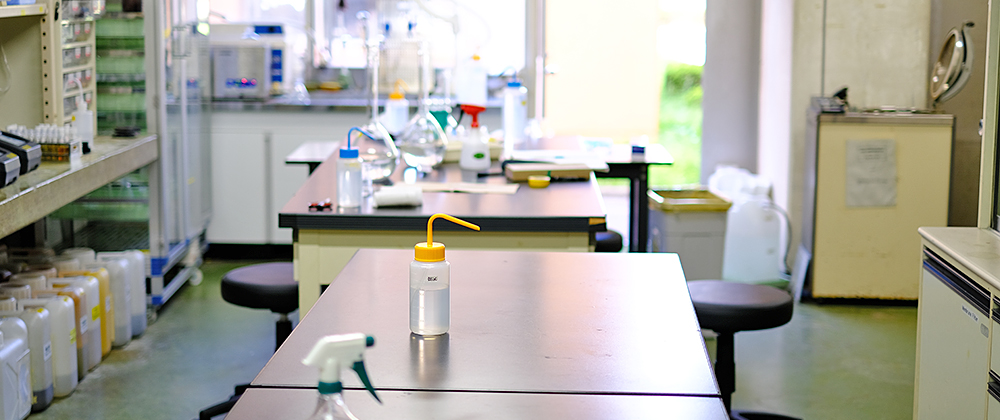
Recovery of minor metals from wastewaters by bioreactor
Minor metals, including rare earth are highly necessary for modern technologies but the natural reserve of them is limited. The demand for minor metals is increasing and then recycling and recovery technologies are required. Biological recovery process has several advantages over the physicochemical system, such as lower energy requirement and none of the production of by-products. While several research on the removal of manganese (Mn) by biological processes, also on the adsorption of heavy metals to Mn oxides have done, promising system for biological removal and recovery of minor metals has not yet been proposed.
Products of dissolved Mn oxidation by bacteria refer to biogenic Mn oxides. These oxides are well known to have high adsorptive capacities and therefore can adsorb a wide range of ions (Tebo et al., 2005). Enrichment of Mn oxidizing bacteria (MnOB), which produce Mn oxides for minor metal adsorption, will probably be a key technology for removal and recovery of rare metals in the future.
Down-flow hanging sponge (DHS) reactor, which has been developed for low-cost wastewater treatment without imposing external aeration, is applicable to enrich MnOB in our laboratory. Beside the enrichment of MnOB, we also enrich sulfate-reducing bacteria and other biological processes using DHS reactor for removal and recovery of minor metals.
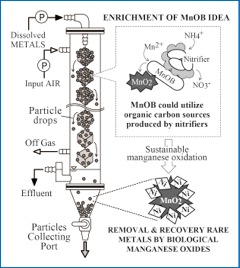
Related publications
- Linh Thi Thuy Cao, Hiroya Kodera, Kenichi Abe, Hiroyuki Imachi, Yoshiteru Aoi, Tomonori Kindaichi, Noriatsu Ozaki, Akiyoshi Ohashi*: Biological oxidation of Mn(II) coupled with nitrification for removal and recovery of minor metals by downflow hanging sponge reactor. Water Research, Vol. 68, No. 1, pp. 545-553. (2015 Jan.) https://doi.org/10.1016/j.watres.2014.10.002
- Shunji Matsushita, Daisuke Komizo, Linh Thi Thuy Cao, Yoshiteru Aoi, Tomonori Kindaichi, Noriatsu Ozaki, Hiroyuki Imachi, Akiyoshi Ohashi*: Production of biogenic manganese oxides coupled with methane oxidation in a bioreactor for removing metals from wastewater. Water Research, Vol. 130, pp. 224-233. (2018 Mar.) https://doi.org/10.1016/j.watres.2017.11.063
- Shuji Matsushita, Takafumi Hiroe, Hiromi Kambara, Ahmad Shoiful, Yoshiteru Aoi, Tomonori Kindaichi, Noriatsu Ozaki, Hiroyuki Imachi, Akiyoshi Ohashi*: Anti-bacterial effects of MnO2 on the enrichment of manganese-oxidizing bacteria in downflow hanging sponge reactors. Microbes and Environments, Vol. 35, ME20052. (2020 Sep.) https://doi.org/10.1264/jsme2.ME20052
- Ha Thi Thu Dinh, Hiromi Kambara, Yoshiki Harada, Shuji Matsushita, Yoshiteru Aoi, Tomonori Kindaichi, Noriatsu Ozaki, Akiyoshi Ohashi*: Bioelectrical methane production with an ammonium oxidative reaction under the no organic substance condition. Microbes and Environments, Vol. 36, No. 2, ME21007. (2021 Jun.) https://doi.org/10.1264/jsme2.ME21007
Phosphorus recovery from wastewater using Polyphosphate Accumulating Organisms (PAOs)
Phosphorus is an essential element for all organisms and is utilized mostly as fertilizers in human society. To establish sustainable use of resources, phosphorus must be recovered during sewage treatment. In wastewater treatment processes, biological phosphorus removal is achieved through phosphorus accumulation by bacteria in activated sludge. The main objective of this study is to develop a novel phosphorus recovery process from wastewater (Figure 1). We focused on the polyphosphate accumulating organisms (PAOs) ecology. The process allows the recovery of phosphate as highly phosphate-concentrated solutions by controlling PAOs to absorb and release phosphate. We are operating a pilot scale reactor using actual sewage (Figure 2) and investigating several important parameters for high performance of phosphorus recovery. In addition, we study and cultivate marine PAOs for phosphorus recovery form high salinity environments (e.g., sea water, factory effluents).
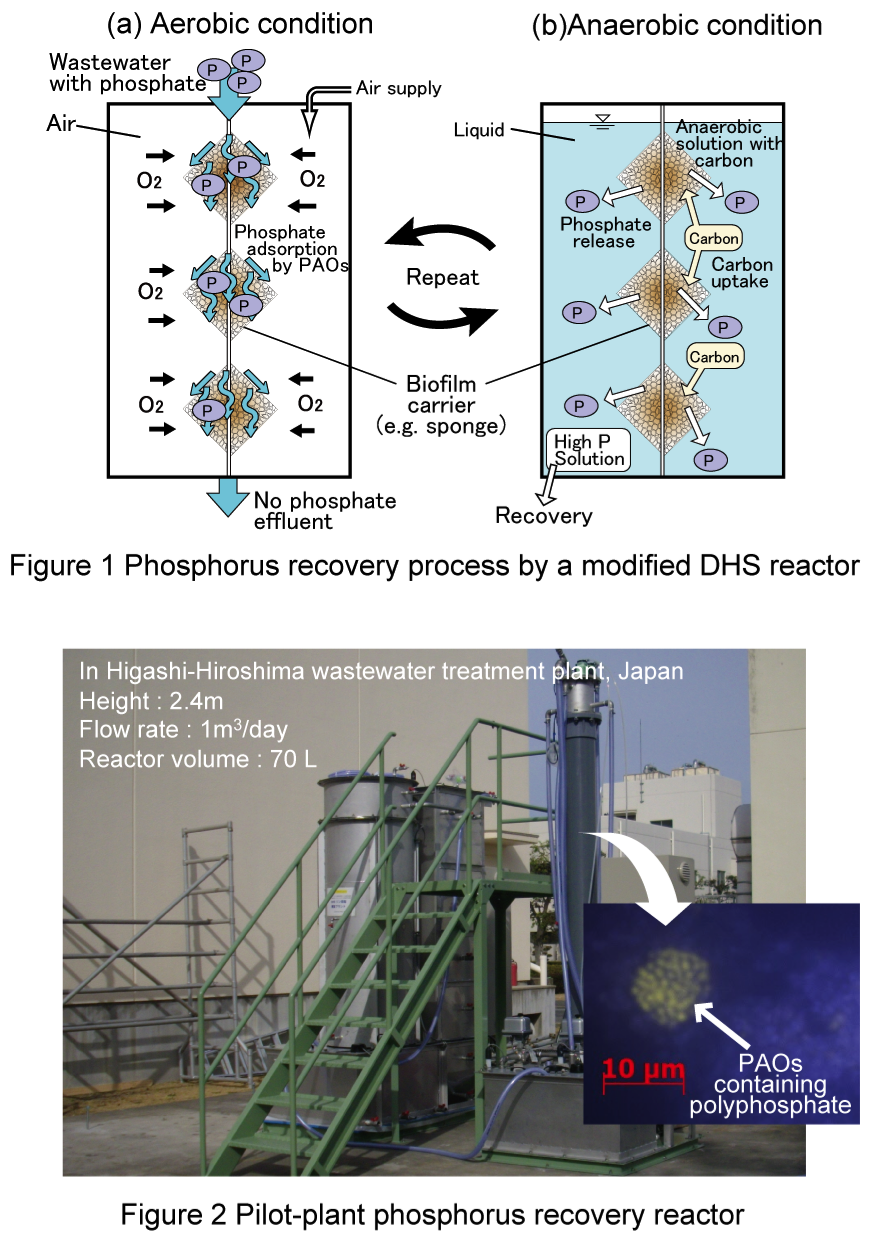
Related publications
- Awaluddin Nurmiyanto, Hiroya Kodera, Tomonori Kindaichi, Noriatsu Ozaki, Yoshiteru Aoi, Akiyoshi Ohashi*: Dominant Candidatus Accumulibacter phosphatis enriched in response to phosphate concentrations in EBPR process. Microbes and Environments, Vol. 32, No. 3, pp. 260-267. (2017 Sep.) https://doi.org/10.1264/jsme2.ME17020
- 小寺 博也, 間口 暢之, 金田一 智規, 尾崎 則篤, 大橋 晶良: 高塩分環境下に生息するポリリン酸蓄積細菌. 土木学会論文集G(環境), Vol. 69, No. 7, pp. III_523-III_530. (2013 Nov.) https://doi.org/10.2208/jscejer.69.III_523
- Hiroya Kodera, Masashi Hatamoto, Kenichi Abe, Tomonori Kindaichi, Noriatsu Ozaki, Akiyoshi Ohashi*: Phosphate recovery as concentrated solution from treated wastewater by a PAO-enriched biofilm reactor. Water Research, Vol. 47, No. 6, pp. 2025-2032. (2013 Apr.) https://doi.org/10.1016/j.watres.2013.01.027
Investigation PAHs environment dynamics
Polycyclic aromatic hydrocarbons (PAHs) are a group of organic compounds composed of two or more fused benzene rings that have been linked to carcinogenicity and mutagenicity. PAHs primarily originate from the incomplete combustion of fossil fuels, which results in their emission into the atmosphere and subsequently into water environments. In terms of preservation of water environment, we measure PAHs content at each stage to clarify PAHs environment dynamics.
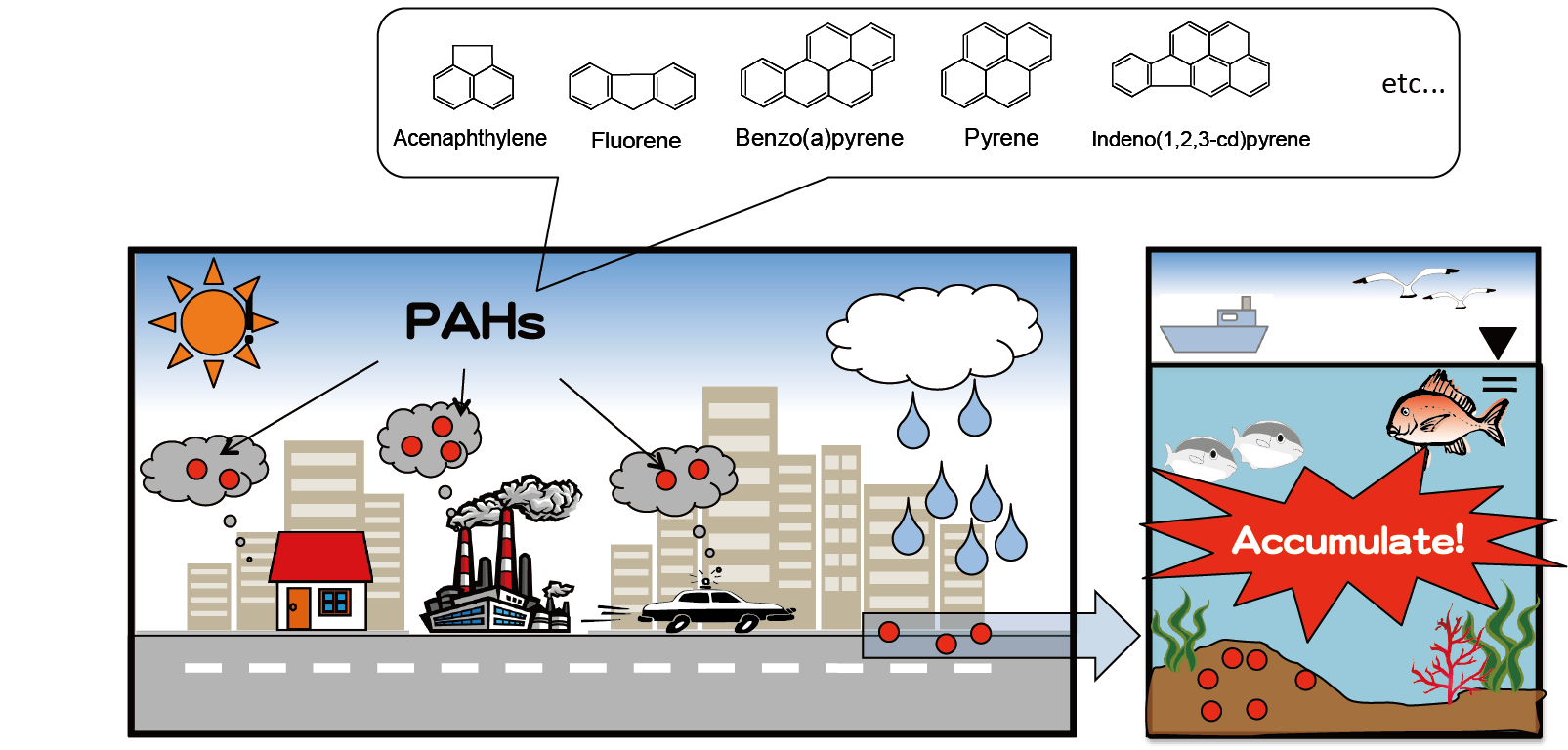
Related publications
- Noriatsu Ozaki*, Akihiro Nakazato, Kazuki Nakashima, Tomonori Kindaichi, Akiyoshi Ohashi: Loading and removal of PAHs, fragrance compounds, triclosan and toxicity by composting process from sewage sludge. Science of the Total Environment. Vol. 605-606, pp. 860-866, (2017 Dec.)
- https://doi.org/10.1016/j.scitotenv.2017.06.165
- Noriatsu Ozaki*, Takahiro Yamauchi, Tomonori Kindaichi, Akiyoshi Ohashi: Stormwater inflow loading of polycyclic aromatic hydrocarbons into urban domestic wastewater treatment plant for separate sewer system. Water Science & Technology, Vol. 79, No. 7, pp. 1426-1436. (2019 Apr.) https://doi.org/10.2166/wst.2019.143
- Noriatsu Ozaki*, Tomonori Kindaichi, Akiyoshi Ohashi: PAHs emission source analysis for air and water environments by isomer ratios -Comparison by modified Cohen’s d. Science of the Total Environment, Vol. 715, 136831. (2020 May) https://doi.org/10.1016/j.scitotenv.2020.136831
Environmental behaviors of polycyclic musks and triclosan
Polycyclic musks and triclosan are compound used as fragrance and antibacterial agent respectively. These compounds are used in consumer products for cleaning or personal care; thus, a large part of the used amount is disposed of with waste water. In the wastewater treatment processes, these compounds are decomposed biologically or volatilized or attached sludge. Residues are discharged into water environment or soil with compost. We investigate environmental fates by measurement of the compounds content at various fields. Also, photolysis is an important decomposition process, and we investigate photolysis of these compounds. We measure the photolytic decomposition of OTNE, HHCB, AHTN and triclosan, by laboratory experiments.
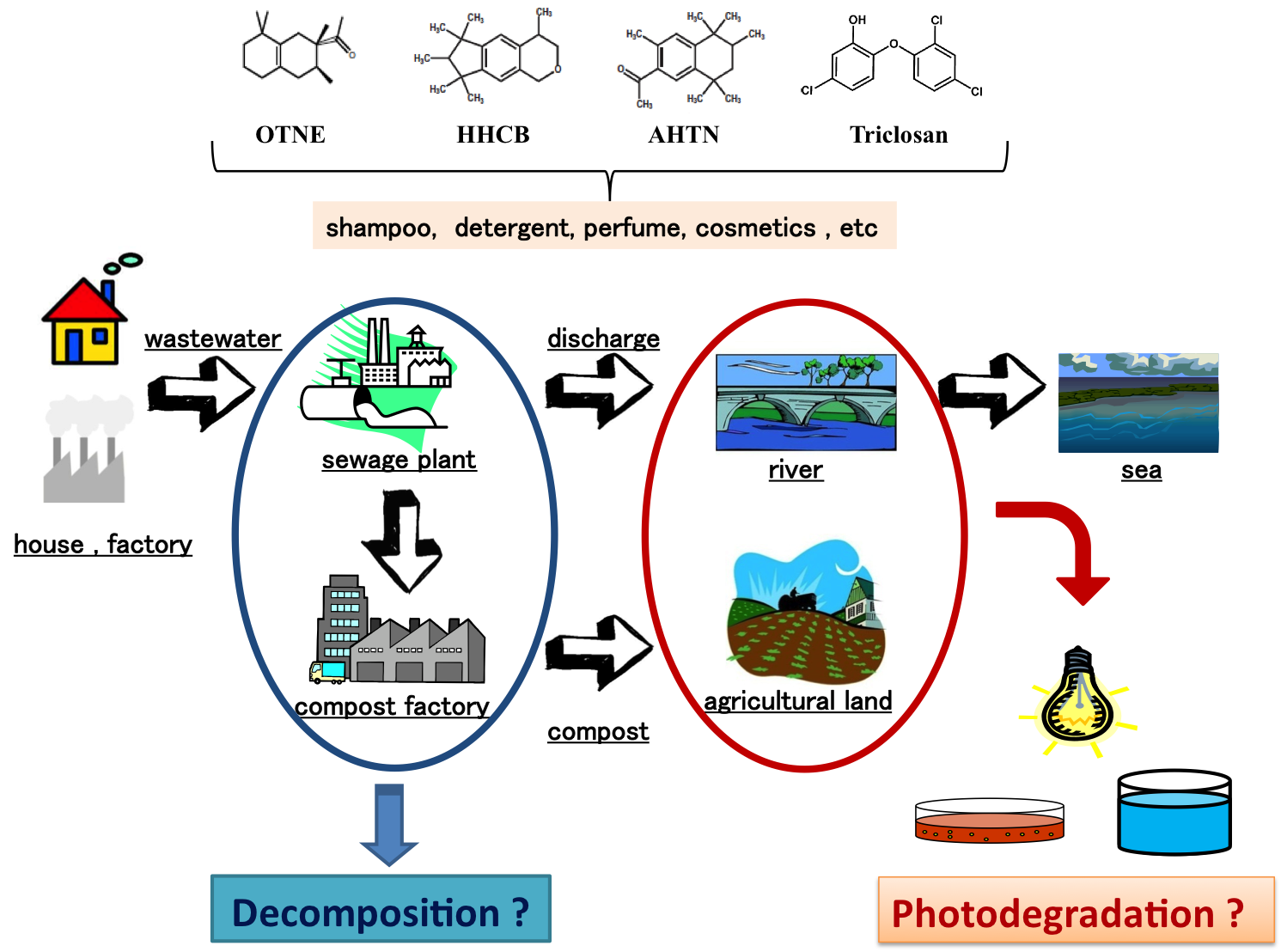
Related publications
- Noriatsu Ozaki*, Mai Nosaka, Hiroki Uemura, Tomonori Kindaichi, Akiyoshi Ohashi: Degradation and volatilization process of fragrance materials and triclosan in wastewater treatment plant – Comparison between field survey and laboratory experiment -. Environmental Technology & Innovation, Vol. 16, pp. 100438. (2019 Jul.) https://doi.org/10.1016/j.eti.2019.100438
- Noriatsu Ozaki*, Tatsunori Tanaka, Tomonori Kindaichi, Akiyoshi Ohashi: Photodegradation of fragrance materials and triclosan in water: Direct photolysis and photosensitized degradation. Environmental Technology & Innovation, Vol. 23, 101766. (2021, Jul.) https://doi.org/10.1016/j.eti.2021.101766
Biological nitrogen removal using anaerobic ammonium oxidation (anammox)
Nitrogen removal from wastewater is essential for preventing eutrophication in closed water areas and nitrate contamination of groundwater. Nitrogen cycle by microorganisms exists in nature (left in the figure below). Among them, anammox is a microbial process that shortcuts the nitrogen cycle and is attracting attention as a highly efficient and energy-saving nitrogen removal process compared to the conventional biological nitrogen removal method (nitrification / denitrification process). However, anammox process is requirement of a long start-up period due to the slow growth rates of anammox bacteria. In our laboratory, we successfully enriched anammox bacteria from activated sludge in a wastewater treatment plant (freshwater anammox bacteria) and from sediments in Hiroshima Bay (marine anammox bacteria) using a column-type bioreactor (right in the figure below). Taking advantage of the characteristics of each anammox bacterium, we try to apply the anammox process to various industrial wastewater, such as, livestock wastewater, and wastewater from recirculating aquaculture systems.
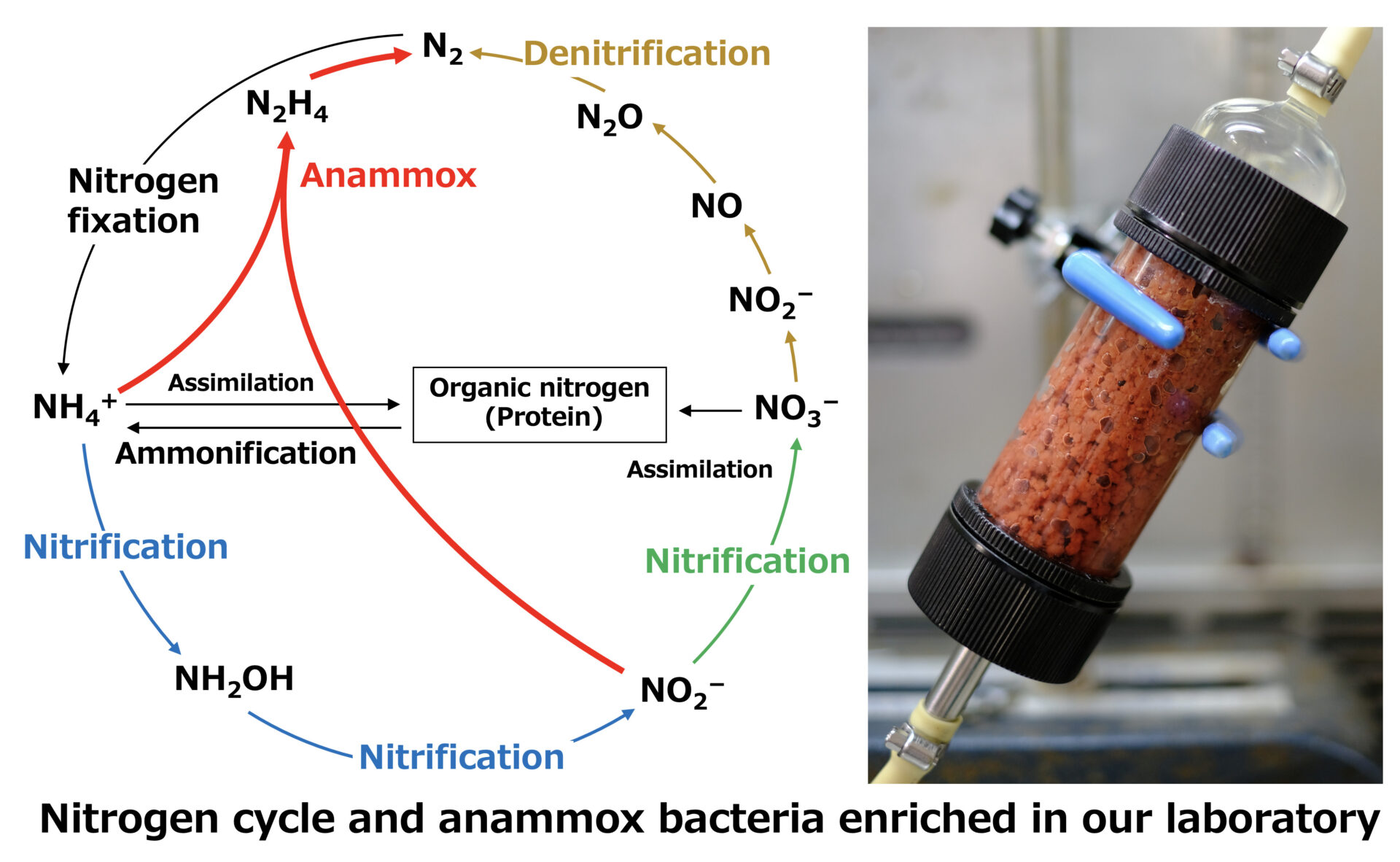
Related publications
- Amin Mojiri, Kazuma Nishimoto, Takanori Awata, Yoshiteru Aoi, Noriatsu Ozaki, Akiyoshi Ohashi, Tomonori Kindaichi*: Effects of salts on the activity and growth of “Candidatus Scalindua sp.”, a marine anammox bacterium. Microbes and Environments, Vol. 33, No. 3, pp. 336-339. (2018 Sep.) https://doi.org/10.1264/jsme2.ME18068
- Suguru Hosokawa, Kyohei Kuroda, Takashi Narihiro, Yoshiteru Aoi, Noriatsu Ozaki, Akiyoshi Ohashi, Tomonori Kindaichi*: Cometabolism of the superphylum Patescibacteria with anammox bacteria in a long-term freshwater anammox column reactor. Water, Vol. 13, No.2, 208. (2021 Jan.) https://doi.org/10.3390/w13020208
- Takanori Awata, Yumiko Goto, Hisashi Kuratuska, Yoshiteru Aoi, Noriatsu Ozaki, Akiyoshi Ohashi, Tomonori Kindaichi*: Reactor performance and microbial community structure of single-stage partial nitritation anammox membrane bioreactors inoculated with Brocadia and Scalindua enrichment cultures. Biochemical Engineering Journal, Vol. 170, 107991. (2021 Mar.) https://doi.org/10.1016/j.bej.2021.107991
- Jonathan A.C. Roques, Federico Micolucci, Suguru Hosokawa, Kristina Sundell, Tomonori Kindaichi*: Effects of recirculating aquaculture system wastewater on anammox performance and community structure. Processes, Vol. 9, No. 7, 1183. (2021 Jul.) https://doi.org/10.3390/pr9071183
Microbial dark matter in activated sludge in municipal wastewater treatment plants
Phylogeny and physiology of microorganisms in activated sludge responsible for the wastewater treatment have not been fully understood yet due to its complexity and variation although activated sludge process has been used for wastewater treatment more than 100 years in worldwide. Most microorganisms, including those in nature and in the engineered system, cannot be cultured and are called as “microbial dark matter”. In such a situation, molecular biological methods, such as 16S rRNA gene analysis and metagenomic analysis have been widely used in many studies to predict the metabolic functions of uncultured bacteria. Big metagenomic data obtained from the activated sludge samples revealed the existence of a huge group of bacteria, called Patescibacteria. In this study, we try to predict the metabolic potential of Patescibacteria in activated sludge and to estimate their physiological role in activated sludge using metagenomic analysis, fluorescence in situ hybridization (below microscopic images), and newly developed isolation techniques.
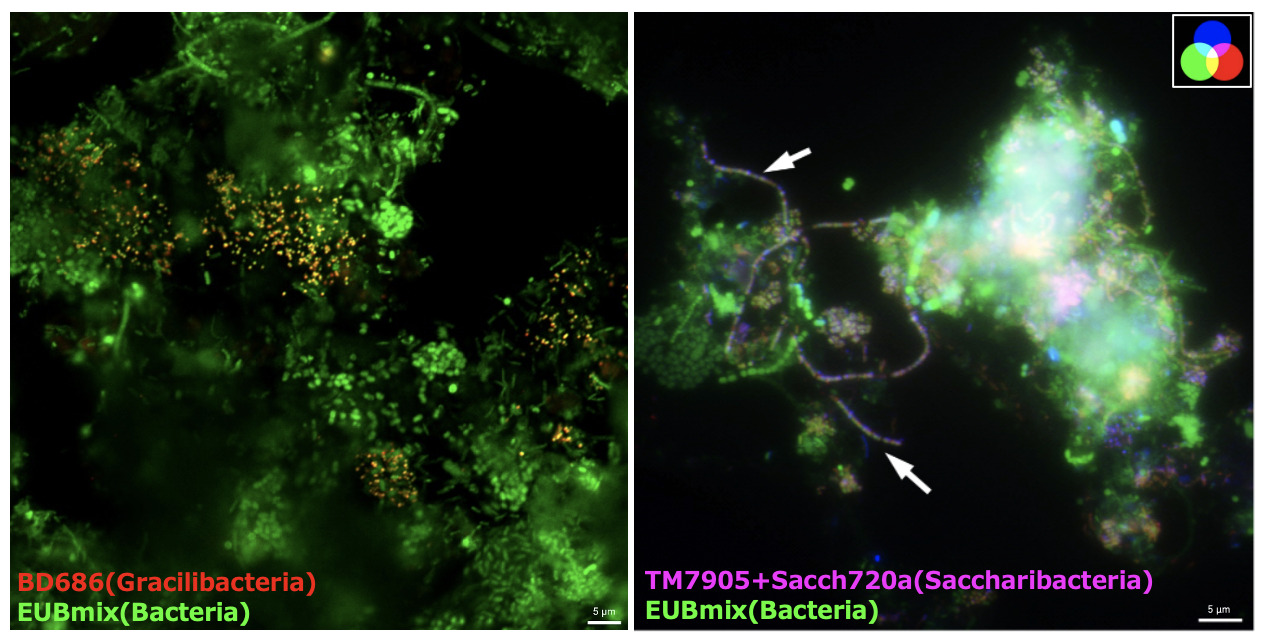
Related publications
- Tomonori Kindaichi, Shiro Yamaoka, Ryohei Uehara, Noriatsu Ozaki, Akiyoshi Ohashi, Mads Albertsen, Per Halkjær Nielsen, Jeppe Lund Nielsen*: Phylogenetic diversity and ecophysiology of candidate phylum Saccharibacteria in activated sludge. FEMS Microbiology Ecology, Vol. 92, No. 6, pp. 1-11. (2016 Jun.) https://doi.org/10.1093/femsec/fiw078
- Ryota Takenaka, Yoshiteru Aoi, Noriatsu Ozaki Akiyoshi Ohashi, Tomonori Kindaichi*. Specificities and efficiencies of primers targeting candidatus phylum Saccharibacteria in activated sludge. Materials, Vol. 11, No. 7, 1129. (2018 Jul.) https://doi.org/10.3390/ma11071129